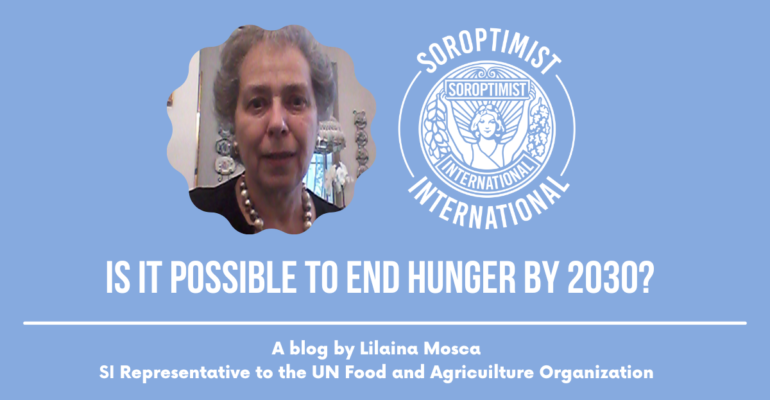Blog of Liliana Mosca, SI UN Representative at the FAO, Rome.
There are 8 years left to meet the UN Sustainable Development Goals and the world is taking steps backward from ending hunger, food insecurity, and malnutrition in all its forms.
Several factors, including conflict, economic shocks and stagnation, a lack of cohesion at the policy level, inadequate food systems and weak supply chains associated with the high cost of nutritious food and growing inequality, will continue to challenge food security and nutrition.
This current scenario is highlighted in the 2022 edition of The State of Food Security and Nutrition in the World (SOFI) report released on 6 July 2022 by the Food and Agriculture Organisation of the United Nations (FAO), the International Fund for Agricultural Development (IFAD), the United Nations Children’s Fund (UNICEF), the United Nations World Food Program (WFP), and the World Health Organisation (WHO).
The report highlights that in spite of progress achieved since the COVID-19 pandemic and increases in global food security, world hunger rose to as many as 828 million in 2021, following a sharp increase in 2020 in the midst of the COVID-19 pandemic.
 Looking ahead, SOFI 2022 projects that nearly 670 million people, or 8% of the world’s population, will still be affected by hunger in 2030 – a number similar to that recorded for 2015 when the 2030 Agenda for Sustainable Development and its SDG 2 (zero hunger) were adopted. The numbers are dramatic. Zero Hunger by 2030 is a mirage.
Looking ahead, SOFI 2022 projects that nearly 670 million people, or 8% of the world’s population, will still be affected by hunger in 2030 – a number similar to that recorded for 2015 when the 2030 Agenda for Sustainable Development and its SDG 2 (zero hunger) were adopted. The numbers are dramatic. Zero Hunger by 2030 is a mirage.
Hunger comes hand-in-hand with inequality. Worldwide, women and girls eat less than men and boys in hard situations such as conflicts, famine, or disasters. Furthermore, although the hunger gap between the genders had been decreased in recent decades, however this has grown considerably both during and in the wake of the COVID-19 pandemic.
The World Food Programme expects that climate change will produce economic and environmental shocks that will exacerbate this inequality, while also noting that this impact can already be seen in Latin America, the Caribbean, Asia, and Africa.
In the current global context, data published by the Global Alliance for Food Security or by UN in The Sustainable Development Goals Report 2022 confirms the food crisis severity and shows that the world is not on track to achieve Zero Hunger and Malnutrition by 2030. The world is also not on track to achieve the 2030 targets for child stunting and low birthweight, both of which are important indicators of severe malnutrition.
This critical moment of the food systems and of global food insecurity can be reversed by achieving a coordinated response to the global food security crisis; specifically, with actions and efforts to attain SDG 2 by 2030 in line with the integrated and indivisible framework of the 17 SDGs as a whole.
In view of a common approach, two key events took place in January 2023 to identify solutions to realise the right to adequate food on a global scale. The first of these events, the Global Forum for Food and Agriculture (GFFA), was held in Berlin from 19 to 21 January and addressed the primary topic of Food Systems Transformation: A Worldwide Response to Multiple Crises. Building on the UN Food Systems Summit, the 2023 GFFA stressed the urgent need for the international global community to promote discussion and explore new possibilities for collaboration in a spirit of partnership.
The second event, held in Dakar, Senegal, from 25 to 27 January, was the Africa Food Summit; here, focusing on the main topic Feed Africa. Food Sovereignty and Resilience, Heads of State convened to mobilise and align government resources, development partners, and private sector financing to fulfil Africa’s food production potential. By removing barriers to agricultural development and through the assistance of new investments, the agricultural output of Africa is anticipated to increase exponentially from $280 billion per year, to $1 trillion by 2030!

